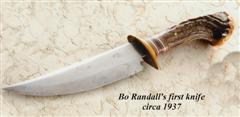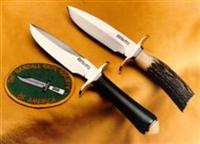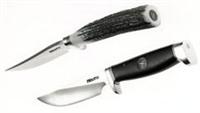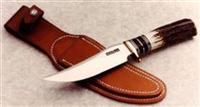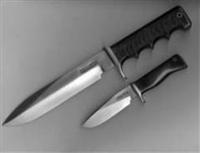
Knife Enthusiast

Registered: 10/15/05
Posts: 1649
Loc: Boogie Wonderland
|
Thanks to all who have participated thus far. From Randall Made Knives: The History of the Man and the Blades by Robert L. Gaddis, pp.222-223. Quote:
In August or early September 1965, Randall Knives attempted to make a small, caping-style knife out of the scrap steel from cut-off tangs. An explanation of terms is in order here. First, a caping knife is a general tem used for a small fixed-blade knife useful for the delicate cutting required to remove the skin from the skull of a game animal so that it may be properly mounted by a taxidermist. Such a knife is especially useful around the eyes, ears, and mouth, or when skinning any small animal for the taxidermist.
Second, concerning scrap steel being generated by cutting off tangs, the blade forgings for all Randall knife models that can be ordered with a leather-washer handle are forged with tangs a little longer than is required for the nut, which is screwed down tight behind the butt cap. When one of these forgings is to be made into a knife without a butt cap on the handle, this tang portion of the forging is much too long, especially if the order calls for a nicely curved stag handle. When a customer specifies a stag handle without butt cap, the first thing a shop craftsman does is take the rough-ground forging over to the Little Bantam Iron Worker machine and cut off about 3 inches off the forged tang....
Being naturally frugal, Bo had often thought about making some types of small knives from these pieces of perfectly good blade steel. Well, in the latter part of the summer of 1965, the shop tried making nice small caping knives out of the longest pieces of these cut-off tangs, but it just didn't work out. As Bo explained, "By the time you forged the tang and tried to get a real decent blade out of it, you couldn't do it. You couldn't get sufficient blade length."
Well, the concept of a knife designed for delicate cutting duties was a good one, even if Randall couldn't make use of the cut-off tang steel, so a fresh bar of steel was used for the forgings.... We do know what the successful result of this fiddling around looks like because, at some point, the little knife became a part of his museum collection....
An interesting feature was the guardless brass hilt, very similar to those used on the earliest Model 8 Trout and Bird knives. The slender stag handle was also characteristic of the early examples of the Model 8. This prototype even had an unusual arrangement of fiber spacers, there being only three in a white-red-white sequence. By the time the model 21 was photographed for the eighteenth printing... it had undergone considerable changes.
The blade was more upswept at the point, and the belly was deeper and more rounded for easier skinning. The small hilt was given a normal single finger guard, and the stag handle was slightly larger in diameter.... In addition, it was now called "Little Game," a title it has kept ever since.
On a personal note, a surgeon friend of mine has a couple of these knives. He tells me that they are such a well-made and balanced knife that he handles it with the deftness of a scalpel.
Lady and gentlemen, may we please see some Model 21s?
Kevin
_________________________
Genesis 27:3
BSC-002
|


